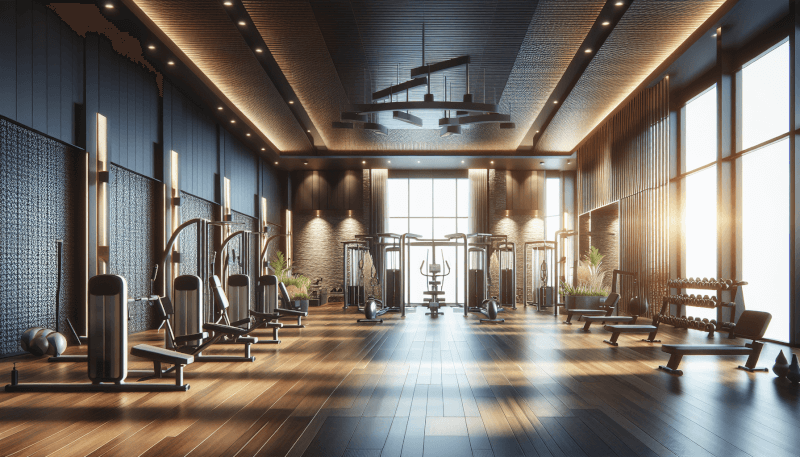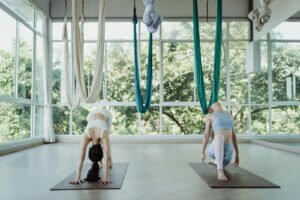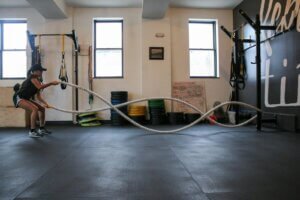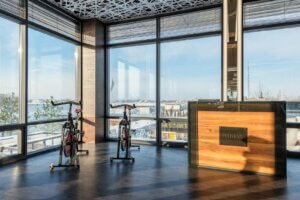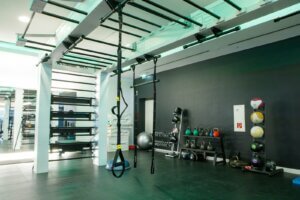If you’re looking to transform your fitness studio into a space that is both functional and visually appealing, you’ve come to the right place. In this article, we’ll explore the world of fitness studio designs and provide you with some practical tips and ideas to create a space that motivates and inspires. Whether you’re starting from scratch or looking to revamp your existing studio, we’ve got you covered. Say goodbye to dull and uninspiring workout spaces, and get ready to elevate your fitness studio to new heights.
Importance of Fitness Studio Design
When it comes to operating a successful fitness studio, the design plays a significant role in creating a welcoming atmosphere, enhancing functionality, and boosting motivation. The overall design of the studio can greatly impact the experience of the members and ultimately determine whether they feel inspired to reach their fitness goals or not. A thoughtfully designed fitness studio can make a world of difference in attracting new members, retaining existing ones, and setting your studio apart from the competition.
Creating a Welcoming Atmosphere
One of the key factors in the success of a fitness studio is creating a welcoming atmosphere that makes members feel comfortable and at ease. The design should emphasize the studio’s brand identity and create a sense of inclusivity. This can be achieved through carefully chosen color schemes, artwork, and branding elements that reflect the studio’s values and mission. Comfortable seating areas, inviting waiting areas, and well-designed locker rooms can also contribute to creating a warm and friendly atmosphere.
Enhancing Functionality
Another crucial aspect of fitness studio design is enhancing functionality. The layout and organization of the space should be carefully planned to ensure optimal flow and usage of the areas. Considerations such as the placement of exercise equipment, changing rooms, and storage spaces should be taken into account to create a seamless experience for members. Additionally, the design should make it easy for instructors to navigate the space efficiently and for members to easily access necessary equipment.
Boosting Motivation
A well-designed fitness studio can have a significant impact on motivation and drive. The atmosphere created by the design should inspire and energize members to push beyond their limits and achieve their fitness goals. This can be achieved by incorporating motivational quotes and images, strategic lighting, and dynamic color schemes. The layout of the equipment and workout spaces can also play a role in fostering a sense of community and encouraging friendly competition among members, further boosting motivation.
Factors to Consider in Fitness Studio Design
When designing a fitness studio, there are several key factors to consider that can greatly influence the overall experience of members.
Space and Layout
The space available for your fitness studio and its layout are essential considerations. It is important to optimize the available space to accommodate the necessary equipment and amenities while also ensuring there is enough room for members to move around comfortably. Factors such as the ceiling height, wall placement, and overall square footage should be taken into account to create a functional and visually appealing layout.
Lighting and Color Scheme
Lighting and color scheme are crucial elements in creating the desired atmosphere in a fitness studio. The lighting should be well-balanced, allowing members to see clearly while also creating a warm and inviting ambience. Natural lighting, if available, should be utilized to its fullest potential. When it comes to the color scheme, it is important to choose colors that promote energy, focus, and positivity. Bright and vibrant colors are often preferred, but it is essential to strike a balance to avoid overwhelming the space.
Equipment and Amenities
Careful consideration should be given to the selection and placement of fitness equipment and amenities in the studio. The equipment should be chosen based on the type of workouts offered, the target audience, and the available space. It is important to provide a variety of equipment to cater to different fitness preferences and goals. Additionally, amenities such as showers, changing rooms, and locker facilities are essential to enhance the overall member experience and convenience.
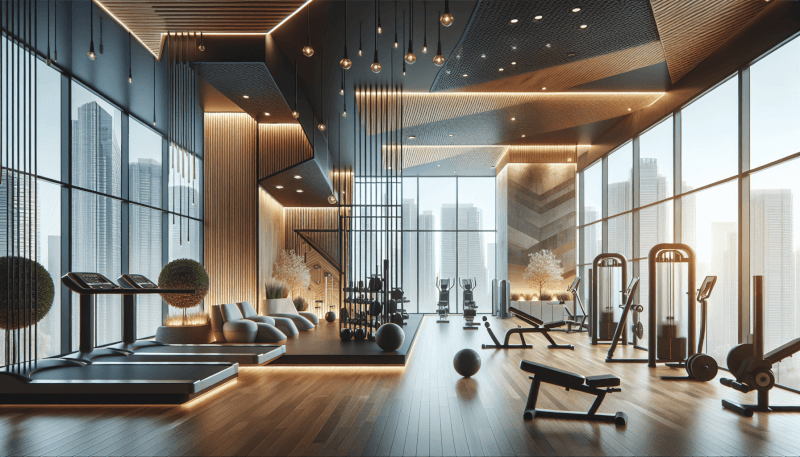
Types of Fitness Studio Designs
Fitness studio designs can vary depending on the target audience, the type of workouts offered, and the overall branding of the studio. Here are three common types of fitness studio designs:
Traditional Gym Design
The traditional gym design focuses on functionality and versatility. It typically features a large open space with a wide range of cardio and strength training equipment. The layout is often divided into specific areas for different types of exercises, such as cardio machines, weightlifting stations, and functional training spaces. Traditional gyms usually cater to a wide range of individuals and offer a variety of workout options.
Boutique Fitness Studio Design
Boutique fitness studios have gained popularity in recent years. They offer specialized classes or workouts focused on specific fitness disciplines, such as yoga, cycling, or high-intensity interval training (HIIT). Boutique studios often have a more intimate atmosphere and a strong brand identity. The design is typically more focused and tailored to the specific workout style, with carefully curated equipment and amenities.
Open Concept Studio Design
Open concept studio designs are characterized by a flexible and versatile space that can be adapted for various types of workouts. These studios often offer a mix of classes and activities, such as group fitness classes, personal training sessions, or small group workouts. The design typically features movable walls or partitions, allowing the space to be easily reconfigured based on the needs of the different activities. Open concept studios promote a sense of community and collaboration among members.
Incorporating Technology in Fitness Studio Design
As technology continues to advance, it has become increasingly important to incorporate technological elements in fitness studio design. Here are some ways to integrate technology into your fitness studio:
Interactive Fitness Equipment
Interactive fitness equipment, such as treadmills with built-in touchscreens or stationary bikes with virtual cycling programs, can provide an immersive and engaging workout experience for members. These technologies allow users to track their progress, compete with others, or follow virtual training sessions. Incorporating such equipment can enhance the overall member experience and keep them motivated.
Digital Training Programs
Digital training programs and applications have become popular tools for fitness enthusiasts. By incorporating digital training platforms into your studio’s design, you can provide access to a wide range of workouts, training programs, and fitness challenges. This allows members to have flexibility in their workout routines and offers additional options beyond the in-person classes offered at the studio.
Smart Climate Control Systems
Smart climate control systems utilize technology to automatically adjust the temperature and air quality in a fitness studio. These systems can ensure a comfortable workout environment by monitoring factors such as humidity and carbon dioxide levels. They can also help save energy by optimizing heating, ventilation, and air conditioning (HVAC) systems based on occupancy and usage patterns.
Trends in Fitness Studio Design
To stay current and relevant in the fitness industry, it is important to be aware of the latest trends in fitness studio design. Here are three prominent trends to consider:
Sustainable and Eco-Friendly Designs
As society becomes more environmentally conscious, sustainability and eco-friendly design have become popular trends in fitness studio design. This includes using sustainable materials, implementing energy-efficient systems, and incorporating natural elements into the design. Green walls, natural lighting, and energy-saving equipment are some examples of how fitness studios can contribute to a more sustainable future.
Multi-Purpose Studio Spaces
Fitness studios are increasingly embracing the concept of multi-purpose spaces to cater to a diverse range of workout styles and activities. By designing flexible spaces that can be easily transformed, studios can offer a variety of classes and workouts throughout the day. This trend allows for better space utilization, increased member engagement, and the opportunity to attract a wider range of fitness enthusiasts.
Outdoor Fitness Areas
Outdoor fitness areas have gained popularity as an extension of indoor fitness studios. These spaces provide members with the opportunity to enjoy workouts in the fresh air and natural surroundings. Outdoor fitness areas can be designed to include functional training equipment, yoga decks, running paths, or outdoor group exercise spaces. This trend not only adds variety to the fitness experience but also connects members with nature and promotes a sense of well-being.
Examples of Outstanding Fitness Studio Designs
To further inspire your fitness studio design, here are three examples of outstanding designs:
Minimalist and Modern Studios
Minimalist and modern studio designs focus on clean lines, open spaces, and simplicity. These studios often incorporate sleek equipment, minimalistic decor, and neutral color palettes. The design elements create a sense of calm and allow the focus to be on the workouts and the member experience.
Nature-Inspired Studios
Nature-inspired studios bring the outdoors inside, creating a calming and refreshing environment. These studios often incorporate natural materials, such as wood and stone, and feature large windows to maximize natural light. Plants and greenery are integrated into the design to enhance the connection with nature and create a sense of tranquility.
Industrial-Chic Studios
Industrial-chic studios embrace raw and reclaimed materials, exposed brick walls, and metal accents to create a unique and edgy atmosphere. These studios often have high ceilings and open layouts, allowing for a sense of spaciousness. Industrial-inspired lighting fixtures and vintage decor elements add character and personality to the space.
Tips for Designing a Fitness Studio on a Budget
Designing a fitness studio on a budget doesn’t mean sacrificing the overall look and functionality. Here are some tips to help you make the most of your budget:
Utilize Repurposed Materials
Instead of purchasing new materials, consider using repurposed or recycled materials. For example, you can use reclaimed wood for flooring or accents, repurpose vintage furniture for the reception area, or find second-hand equipment that is still in good condition. Not only will this help reduce costs, but it will also give your studio a unique and environmentally friendly touch.
Optimize Space Efficiency
Maximize the functionality of your fitness studio by carefully planning the layout and utilizing space-saving solutions. Be strategic in the placement of equipment and amenities to ensure optimal flow and usage of the available space. Consider installing wall-mounted storage racks or using multifunctional furniture to save space and reduce clutter.
Focus on Essential Equipment
When working with a limited budget, prioritize investing in essential equipment that will cater to the majority of your members’ needs. This will allow you to provide a variety of workout options without overspending. You can always add more equipment as your studio grows and your budget allows.
Design Considerations for Different Types of Fitness Studios
Different types of fitness studios require specific design considerations to accommodate the unique needs of each workout style. Here are some design considerations for specific types of fitness studios:
Cardio and Strength Training Studios
Cardio and strength training studios should prioritize spacious layouts with proper airflow and ventilation to accommodate high-intensity workouts. The layout should allow for easy access to cardio machines such as treadmills, ellipticals, and stationary bikes, as well as weightlifting equipment. Adequate flooring that absorbs impact is essential for safety and comfort during weightlifting exercises.
Yoga and Pilates Studios
Yoga and Pilates studios should focus on creating a calm and peaceful atmosphere. Natural lighting, neutral colors, and serene artwork can help create this ambiance. The layout should allow for ample space for yoga mats, props, and equipment. Additionally, proper storage solutions for yoga mats and props can help keep the space organized and clutter-free.
Dance and Aerobics Studios
Dance and aerobics studios require specialized flooring that provides shock absorption and slip resistance. Mirrors along the walls are essential for participants to see their movements and correct form. The layout should allow for ample open space for dancing or aerobic routines. Finally, considering the use of soundproofing materials can help minimize noise disruptions for neighboring spaces.
Creating a Functional and Inviting Reception Area
The reception area plays a critical role in making a positive first impression on members and potential clients. Here are some key design considerations for creating a functional and inviting reception area:
Ergonomic Reception Desk
The reception desk should be both visually appealing and functional. It should be designed with the ergonomic needs of reception staff in mind, ensuring comfort and efficiency. The desk should have ample space for computers, paperwork, and storage. Consider incorporating built-in storage solutions to minimize clutter and maximize organization.
Comfortable Waiting Area
Create a comfortable and inviting waiting area for members and guests. Provide seating options that are both aesthetically pleasing and comfortable, such as plush chairs or sofas. Consider incorporating amenities like water stations or a small cafe area where members can relax and socialize before or after their workouts.
Visible Branding and Marketing Material
The reception area is a prime location for showcasing your studio’s branding and marketing material. Display your logo prominently and incorporate the studio’s colors and fonts throughout the space. Use the reception area to feature promotional materials, success stories, and testimonials to inspire and motivate both current and potential members.
Importance of Regular Maintenance and Upgrades
Maintaining your fitness studio’s design and equipment is crucial to ensure a safe and enjoyable experience for members. Regular maintenance and upgrades help keep your studio up to date and aligned with industry trends. Here are some key areas to focus on:
Equipment Maintenance
Regular equipment maintenance is essential to ensure the safety and functionality of the equipment. Implement a routine maintenance schedule that includes regular inspections, cleaning, and repairs. Monitoring equipment usage and tracking maintenance records can help identify equipment that may need to be upgraded or replaced.
Updating Design Elements
Design trends and member preferences evolve over time, making it important to periodically update design elements to keep your studio fresh and appealing. This can include updating artwork, refreshing paint or wall coverings, and replacing worn-out flooring or fixtures. Regularly assessing the overall aesthetic of the studio and making necessary updates will help maintain member engagement and satisfaction.
Staying Relevant with Industry Trends
Regularly monitoring industry trends and staying informed about new design innovations is crucial to maintaining a competitive edge in the fitness industry. Stay connected with industry publications, attend trade shows, and network with other fitness professionals to stay up to date with the latest trends in fitness studio design. By incorporating fresh ideas and staying relevant, your studio will remain attractive to both current and prospective members.
In conclusion, the design of a fitness studio plays a vital role in creating a welcoming atmosphere, enhancing functionality, and boosting motivation. By considering factors such as space and layout, lighting and color scheme, and equipment and amenities, you can create a fitness studio that caters to the unique needs of your target audience. Incorporating technology, being mindful of design trends, and providing outstanding examples of fitness studio designs will help set your studio apart from the competition. Lastly, prioritizing regular maintenance, upgrades, and creating a functional and inviting reception area will contribute to the overall success and longevity of your fitness studio.

